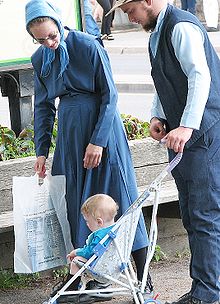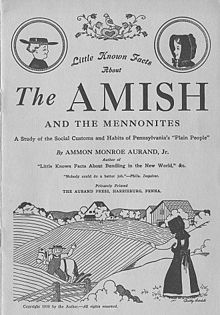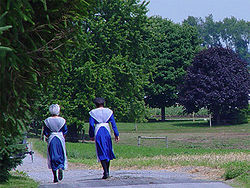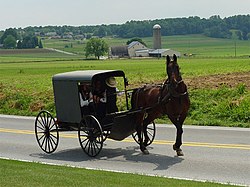The Amish (
In the early 18th century, many Amish and Mennonites emigrated to Pennsylvania for a variety of reasons. Today, the most traditional descendants of the Amish continue to speak Pennsylvania German, also known as Pennsylvania Dutch. However, a dialect of Swiss German predominates in some Old Order Amish communities, especially in the American state of Indiana.[4] As of 2000, over 165,000 Old Order Amish live in the United States and approximately 1500 live in Canada.[5] A 2008 study suggested their numbers have increased to 227,000,[6] and in 2010 a study suggested their population had grown by 10% in the past two years to 249,000, with increasing movement to the West.[1]
Amish church membership begins with baptism, usually between the ages of 16 and 25. It is a requirement for marriage, and once a person has affiliated with the church, he or she may marry only within the faith. Church districts average between 20 and 40 families, and worship services are held every other Sunday in a member's home. The district is led by a bishop and several ministers and deacons.[7] The rules of the church, the Ordnung, must be observed by every member. These rules cover most aspects of day-to-day living, and include prohibitions or limitations on the use of power-line electricity, telephones, and automobiles, as well as regulations on clothing. Many Amish church members may not buy insurance or accept government assistance such as Social Security. As Anabaptists, Amish church members practice nonresistance and will not perform any type of military service.
Members who do not conform to these expectations and who cannot be convinced to repent are excommunicated. In addition to excommunication, members may be shunned, a practice that limits social contacts to shame the wayward member into returning to the church. During adolescence rumspringa ("running around") in some communities, nonconforming behavior that would result in the shunning of an adult who had made the permanent commitment of baptism, may meet with a degree of forbearance.[8] Amish church groups seek to maintain a degree of separation from the non-Amish (English) world. There is generally a heavy emphasis on church and family relationships. They typically operate their own one-room schools and discontinue formal education at grade eight (age 13/14). They value rural life, manual labor and humility.
History

An old Amish cemetery in Lancaster County, Pennsylvania, 1941.
The Amish movement takes its name from Jakob Ammann (c. 1656–1730), a Swiss Mennonite leader. Ammann believed Mennonites, the peaceful Anabaptists of the Low Countries and Germany, were drifting away from the teachings of Menno Simons and the 1632 Mennonite Dordrecht Confession of Faith. Ammann favored stronger church discipline, including a more rigid application of shunning, the social exclusion of excommunicated members. Swiss Anabaptists, who were scattered by persecution throughout the Alsace and the Electorate of the Palatinate, never practiced strict shunning as had some lowland Anabaptists.[citation needed] Ammann insisted upon this practice, even to the point of expecting spouses to refuse to eat with each other, until the banned spouse repented.[11] This type of strict literalism, on this issue, as well as others, brought about a division among the Mennonites of Southern Germany, the Alsace and Switzerland in 1693, and led to withdrawal of those who sided with Ammann.
Swiss Anabaptism developed, from this point, in two parallel streams. Those following Ammann became known as Amish or Amish Mennonite. The others eventually formed the basis of the Swiss Mennonite Conference. Because of this common heritage, Amish and Mennonites retain many similarities. Those who leave the Amish fold tend to join various congregations of Conservative Mennonites.[12][13]
Amish Mennonites began migrating to Pennsylvania in the 18th century as part of a larger migration from the Palatinate and neighboring areas. This migration was a reaction to religious wars, poverty, and religious persecution on the Continent.[citation needed] The first Amish immigrants went to Berks County, Pennsylvania, but later moved, motivated by land issues and by security concerns tied to the French and Indian War.[citation needed] Many eventually settled in Lancaster County, Pennsylvania. Other groups later settled in, or spread to Alabama, Delaware, Illinois, Indiana, Iowa, Kansas, Kentucky, Michigan, Minnesota, Mississippi, Missouri, Montana, Nebraska, New York, Ohio, Maryland, Tennessee, Wisconsin, Maine, and Ontario, Canada.
The Amish congregations remaining in Europe slowly merged with the Mennonites. The last Amish congregation to merge was the Ixheim Amish congregation, which merged with the neighboring Mennonite Church in 1937. Some Mennonite congregations, including most in Alsace, are descended directly from former Amish congregations.[14]
Most Amish communities that were established in North America did not ultimately retain their Amish identity. The original major split that resulted in the loss of identity occurred in the 1860s. During that decade Dienerversammlungen (ministerial conferences) were held in Wayne County, Ohio, concerning how the Amish should deal with the pressures of modern society. The meetings themselves were a progressive idea; for bishops to assemble to discuss uniformity was an unprecedented notion in the Amish church.[citation needed] By the first several meetings, the more traditionally minded bishops agreed to boycott the conferences. The more progressive members, comprising approximately two thirds of the group, retained the name Amish Mennonite. Many of these eventually united with the Mennonite Church, and other Mennonite denominations, especially in the early 20th century. The more traditionally minded groups became known as the Old Order Amish.[15]
Religious practices
Main article: Amish religious practices

Amish couple in horse-driven buggy in rural Holmes County, Ohio, September 2004)
Way of life
Main article: Amish way of life
Amish lifestyle is dictated by the Ordnung (German, meaning: order),
which differs slightly from community to community, and, within a
community, from district to district. What is acceptable in one
community may not be acceptable in another. No summary of Amish
lifestyle and culture can be totally adequate, because there are few
generalities that are true for all Amish. Groups may separate over
matters such as the width of a hat-brim, the color of buggies, or other
issues.Bearing children, raising them, and socializing with neighbors and relatives are the greatest functions of the Amish family. All Amish believe large families are a blessing from God.
Language
Main article: Pennsylvania German language
According to one scholar, "today, almost all Amish are functionally
bilingual in Pennsylvania Dutch and English; however, domains of usage
are sharply separated. Pennsylvania Dutch dominates in most in-group
settings, such as the dinner table and preaching in church services. In
contrast, English is used for most reading and writing. English is also
the medium of instruction in schools and is used in business
transactions and often, out of politeness, in situations involving
interactions with non-Amish. Finally, the Amish read prayers and sing in
Standard German, or High German
(Hoch Deitsch) at church services. The distinctive use of three
different languages serves as a powerful conveyor of Amish identity."[16]
Although "the English language is being used in more and more
situations," Pennsylvania Dutch is "one of a handful of minority
languages in the United States that is neither endangered nor supported
by continual arrivals of immigrants."[17]Population and distribution

Amish family shopping near Niagara Falls, Ontario
| Historical population | ||
|---|---|---|
| Year | Pop. | ±% |
| 1920 | 5,000 | — |
| 1928 | 7,000 | +40.0% |
| 1936 | 9,000 | +28.6% |
| 1944 | 13,000 | +44.4% |
| 1952 | 19,000 | +46.2% |
| 1960 | 28,000 | +47.4% |
| 1968 | 39,000 | +39.3% |
| 1976 | 57,000 | +46.2% |
| 1984 | 84,000 | +47.4% |
| 1992 | 125,000 | +48.8% |
| 2000 | 166,000 | +32.8% |
| 2008 | 221,000 | +33.1% |
| 2010 | 249,000 | +12.7% |
| US Populations sources: 221,000 in 2008;[6] 249,000 in 2010.[1] |
||
There are Old Order communities in 27 U.S. states and the Canadian province of Ontario; Ohio has the largest population (55,000), followed by Pennsylvania (51,000) and Indiana (38,000).[22] The largest Amish settlements are in Holmes County in central Ohio, Lancaster County in south-central Pennsylvania, and Elkhart and LaGrange counties in northeast Indiana.[23] The largest concentration of Amish west of the Mississippi River is in Missouri, with other settlements in eastern Iowa and Southeast Minnesota.[24] In addition, there is a population of approximately 10,000 Old Order Amish in West Central Wisconsin.[25] Because of rapid population growth in Amish communities, new settlements are formed to obtain sufficient farmland. Other reasons for new settlements include locating in isolated areas that support their lifestyle, moving to areas with cultures conducive to their way of life, maintaining proximity to family or other Amish groups, and sometimes to resolve church or leadership conflicts.[19]
A small Beachy Amish congregation associated with Weavertown Amish Mennonite Church exists in the Republic of Ireland.[26]
Ethnicity
The Amish largely share a German or Swiss-German ancestry. They generally use the term "Amish" only for members of their faith community, and not as an ethnic designation. Those who choose to affiliate with the church, or young children raised in Amish homes, but too young to yet be church members, are considered to be Amish. Certain Mennonite churches have a high number of people who were formerly from Amish congregations. Although more Amish immigrated to America in the 19th century than during the 18th century, most of today's Amish descend from 18th-century immigrants. The latter tended to emphasize tradition to a greater extent, and were perhaps more likely to maintain a separate Amish identity.[27] There are a number of Amish Mennonite church groups that had never in their history been associated with the Old Order Amish.[citation needed] The former Western Ontario Mennonite Conference (WOMC) was made up almost entirely of former Amish Mennonites who reunited with the Mennonite Church in Canada.[28] Orland Gingerich's book The Amish of Canada devotes the vast majority of its pages not to the Beachy or Old Order Amish, but to congregations in the former WOMC.Health
Amish populations have higher incidences of particular genetic disorders, including dwarfism (Ellis–van Creveld syndrome),[29] and various metabolic disorders,[30] as well as an unusual distribution of blood types.[31] Amish represent a collection of different demes or genetically closed communities.[32] Since almost all Amish descend from about 200 18th-century founders, genetic disorders that come out due to inbreeding exist in more isolated districts (an example of the founder effect). Some of these disorders are quite rare, or unique, and are serious enough to increase the mortality rate among Amish children. The majority of Amish accept these as "Gottes Wille" (God's will); they reject use of preventive genetic tests prior to marriage and genetic testing of unborn children to discover genetic disorders. However, Amish are willing to participate in studies of genetic diseases. Their extensive family histories are useful to researchers investigating diseases such as Alzheimer's, Parkinson's, and macular degeneration.While the Amish are at an increased risk for a number of genetic disorders, researchers at The Ohio State University Comprehensive Cancer Center—Arthur G. James Cancer Hospital and Richard J. Solove Research Institute (OSUCCC-James) have found their tendencies for clean living can lead to a healthier life. Overall cancer rates in the Amish population are 60 percent of the age-adjusted rate for Ohio and 56 percent of the national rate. The incidence of tobacco-related cancers in the Amish adults is 37 percent of the rate for Ohio adults, and the incidence of non-tobacco-related cancer is 72 percent. The Amish have protection against many types of cancer both through their lifestyle—there is very little tobacco or alcohol use and limited sexual partners—and through genes that may reduce their susceptibility to cancer. Dr. Judith Westman, director of human genetics at OSUCCC-James, conducted the study. The findings were reported in a recent issue of the journal Cancer Causes & Control. Even skin cancer rates are lower for Amish, despite the fact many Amish make their living working outdoors where they are exposed to sunlight and UV rays. They are typically covered and dressed to work in the sun by wearing wide-brimmed hats and long sleeves to protect their skin.[33]
The Amish are conscious of the advantages of exogamy. A common bloodline in one community will often be absent in another, and genetic disorders can be avoided by choosing spouses from unrelated communities. For example, the founding families of the Lancaster County Amish are unrelated to the founders of the Perth County, Ontario Amish community. Because of a smaller gene pool, some groups have increased incidences of certain inheritable conditions.[34]
The Old Order Amish do not typically carry private commercial health insurance. About two-thirds of the Amish in Lancaster County participate in Church Aid, an informal self-insurance plan for helping members with catastrophic medical expenses.[35] A handful of American hospitals, starting in the mid-1990s, created special outreach programs to assist the Amish. The first of these programs was instituted at the Susquehanna Health System in central Pennsylvania by James Huebert. This program has earned national media attention in the United States, and has spread to several surrounding hospitals.[36][37] Treating genetic problems is the mission of Clinic for Special Children in Strasburg, Pennsylvania, which has developed effective treatments for such problems as maple syrup urine disease, a previously fatal disease. The clinic is embraced by most Amish, ending the need for parents to leave the community to receive proper care for their children, an action that might result in shunning.
DDC Clinic for Special Needs Children, located in Middlefield, Ohio, has been treating special-needs children with inherited or metabolic disorders since May 2002.[38] The DDC Clinic provides treatment, research, and educational services to Amish and non-Amish children and their families.
Although not forbidden or thought of as immoral, most Amish do not practice any form of birth control, hence their large families. They are against abortion and also find "artificial insemination, genetics, eugenics, and stem cell research" to be "inconsistent with Amish values and beliefs".[39]
People's Helpers is an Amish-organized network of mental health caregivers who help families dealing with mental illness and recommend professional counselors.[40] Suicide rates for the Amish of Lancaster County were 5.5 per 100,000 in 1980, about half that of the general population and a third the rate of the non-religious population.[41]
Amish life in the modern world
Main article: Amish life in the modern world
As time has passed, the Amish have felt pressures from the modern
world. Issues such as taxation, education, law and its enforcement, and
occasional discrimination and hostility, are areas of difficulty.The Amish way of life in general has increasingly diverged from that of modern society. On occasion, this has resulted in sporadic discrimination and hostility from their neighbors, such as throwing of stones or other objects at Amish horse-drawn carriages on the roads.[42][43][44]
The Amish do not usually educate their children past the eighth grade, believing that the basic knowledge offered up to that point is sufficient to prepare one for the Amish lifestyle. Almost no Amish go to high school and college. In many communities, the Amish operate their own schools, which are typically one-room schoolhouses with teachers (young unmarried women) from the Amish community. On May 19, 1972, Jonas Yoder and Wallace Miller of the Old Order Amish, and Adin Yutzy of the Conservative Amish Mennonite Church, were each fined $5 for refusing to send their children, aged 14 and 15, to high school. In Wisconsin v. Yoder, the Wisconsin Supreme Court overturned the conviction,[45] and the U.S. Supreme Court affirmed this, finding the benefits of universal education do not justify a violation of the Free Exercise Clause of the First Amendment.[46]
Like other citizens, Amish pay sales and property taxes. However, Amish buggies, bicyclists, and pedestrians use public highways, but need not pay either motor vehicle registration fees or motor fuel taxes.[47] Under their beliefs and traditions, the Amish do not agree with the idea of social security benefits and have a religious objection to insurance. On this basis, the United States Internal Revenue Service agreed in 1961 that they did not need to pay Social Security related taxes. In 1965, this policy was codified into law.[48] Self-employed individuals in certain sects do not pay into, nor receive benefits from, United States Social Security. This exemption applies to members of a religious group that is conscientiously opposed to accepting benefits of any private or public insurance, provides a reasonable level of living for its dependent members and has existed continuously since December 31, 1950.[49] The U.S. Supreme Court in 1982 clarified that Amish employers are not exempt, but only those Amish individuals who are self-employed.[50]
Publishing
The Old Order Amish support an unofficial publishing house known as Pathway Publishing Company in Lagrange, Indiana, and Aylmer, Ontario. Pathway publishes a number of school text books, general reading books, and periodicals.Subgroups of Amish
Main article: Subgroups of Amish
Over the years, the Amish churches have divided many times over
doctrinal disputes. The "Old Order" Amish, a conservative faction that
withdrew from fellowship with the wider body of Amish in the 1860s, are
those that have most emphasized traditional practices and beliefs. There
are as many as eight different subgroups of Amish with most belonging,
in ascending order of conservatism, to the Beachy Amish, New Order, Old
Order, or Swartzentruber Amish sects.Conflicts
Conflicts between subgroups of Amish have resulted in instances of "beard cutting" attacks on members of the Amish community.[51][52] Due to the cloistered nature of Amish lifestyle, they are often reluctant to bring complaints to local police[53] who describe the attacks as "very rare". In September, 2012, a group of 16 Amish men and women from Bergholz, Ohio, were convicted on Federal hate-crime and conspiracy charges, including Samuel Mullet Sr., who did not participate in the five hair- and beard-cutting attacks but was tried as the leader of the campaign.[54]Similar groups
Old Order Mennonites, Conservative Mennonites, Hutterites, and Old German Baptist Brethren are distinct from the Amish. They all emigrated from Europe, but they arrived with different dialects, separate cultures, and diverse religious traditions.[55] Particularly, the Hutterites live communally[56] and are generally accepting of modern technology.[57]Plain Quakers are similar in manner and lifestyle, but unrelated to the Amish.[58] Early Quakers were influenced, to some degree, by the Anabaptists. Most modern Quakers have since abandoned their traditional dress.[59]
Portrayal in popular entertainment
Film
Topical
Peter Weir's 1985 drama Witness is set and filmed in the Amish community of Lancaster County, Pennsylvania. Harvest of Fire is a 1996 Hallmark Hall of Fame made-for-TV movie about an FBI agent's investigation of cases of suspected arson in an Amish farming community. The 2002 documentary Devil's Playground follows a group of Amish teenagers during rumspringa, and it portrays their personal dilemma with both the "English" world and the decision on whether or not to be baptized as adult members of the church.In Kingpin, a former bowling champion coaches a young Amish man in winning a bowling tournament to win enough money to save his family's farm.
Michael Landon, Jr.'s 2007 film Saving Sarah Cain, based on the novel The Redemption of Sarah Cain by Beverly Lewis, shows the removal of young Amish children to the big city and realizing the life they can have with both the Amish and English world. Producer Larry Thompson's 2010 Lifetime Original Movie.
The Heritage of Lancaster County, another series by Beverly Lewis, is the inspiration for a trio of movies on the Hallmark Channel beginning with The Shunning. It follows Katie Lapp, a young Amish woman with ties to the English world and her struggle to find where she belongs.
Amish Grace portrayed the events surrounding an Amish school shooting in Nickel Mines, Pennsylvania.
Episodical
In the comedy Sex Drive, the three main characters hitchhike with an Amish man, played by Seth Green, who takes them to his home. There they find a party during rumspringa, where the character Lance meets his future love interest in the film. In the George Romero film Diary of the Dead, a deaf Amish man appears and helps the main survivors before killing himself after being infected.For Richer or Poorer is a 1997 comedy film starring Tim Allen and Kirstie Alley, who find themselves hiding in a small Amish community in Pennsylvania.








